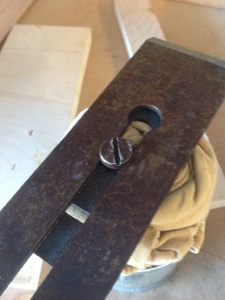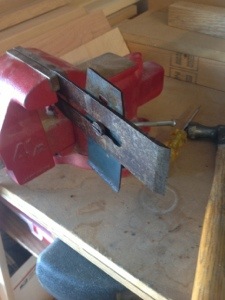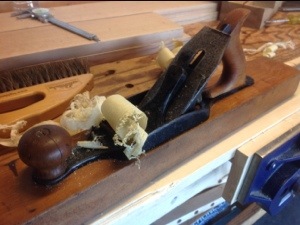Transition Planes
Several people have spoken about the qualities of wood planes. Until several months ago I had little knowledge of transition planes and even then it was a passing comment about their feel as they glide across a board. A few weeks ago I was handed a box of old planes; I was a little surprised, but many of us have been given tools from friends, relatives and people down the street.

As a struggled to put words onto the computer screen last week my eyes strolled over to the cardboard box that rested on my bench. Reaching in I sorted through the planes until my hand fell upon the metal of this transition plane. The wood was dry, the blade blunt and rusty and the tote loose. Deciding that at the least a little linseed oil was needed, I spent several minutes wiping the dirt and grime from the wood and metal.
The linseed oil soaked into the wood rapidly and several coats later the beauty of the plane began to shine through. I cleaned and added wax to the japanning on the metal and the plane really began to catch my eye. Leaving the plane to dry, I continued working on several other projects intending to place the plane in my tool box to be worked on at another time. It caught my eye several more times and I continued to add Linseed oil until the wood could hold no more.
 After the last coat of oil I began placing the blade into the plane, but at the last minute decided to oil it up to prevent further rust. An hour later I had forced the blade and chip breaker apart (force is a polite term) removed rust and sharpened the blade and begun cleaning the frog. I had not realized that these planes have the adjustment of a stanley plane. This is one of the factors that had prevented me from acquiring wood planes in the past. I like the fine control of the mechanical adjustment. At this point there is a certain excitement about trying a wooden plane with the fine adjustment of a Stanley #4.
After the last coat of oil I began placing the blade into the plane, but at the last minute decided to oil it up to prevent further rust. An hour later I had forced the blade and chip breaker apart (force is a polite term) removed rust and sharpened the blade and begun cleaning the frog. I had not realized that these planes have the adjustment of a stanley plane. This is one of the factors that had prevented me from acquiring wood planes in the past. I like the fine control of the mechanical adjustment. At this point there is a certain excitement about trying a wooden plane with the fine adjustment of a Stanley #4.
I grabbed a scrap piece of poplar and clamped it into my vise. Adjusting the plane I eased it onto the wood and felt the blade bite, a little too deep. I spun the adjustment wheel and placed the plane back on the board. Swisch…..
Back to the begining of the board, I push forward again, Swisch….clearly the plane did not say Swish…there was a definite c in the spelling. The wooden sole glided across the board and the blade sliced through the wood. I began easing the plane back and forth across the board feeling it work and hearing the sound as it removed slice after slice. Wow!!!!!!!
John Patrick, your cardboard box of planes has revealed the soul of a wooden plane and put a smile on a woodworker’s face. What a wonderful gift!!! Keep well my friend and know the planes are in great hands.




Transitional planes are a joy to use. Their wooden bed makes them easy to fettle. Carpenters preferred transitionals over their modern counterparts due to their weight. Imagine fitting doors all day everyday with a Stanley No 8. I bought a Stanley 107 on eBay a few years ago for a $1.00. I use it as a fore plane and it works great. Patrick Leach is just one oppinion. Dont let him persuade you too much.
Actually my transitional plane is a Stanley #27 not #107. I mentioned Patrick Leach because I thought you may be referring to his Blood and Gore website where he shows a burning transitional plane. http://supertool.com/StanleyBG/stan4.htm#num27
I was at my in-laws farm house a few summers ago and lo and behold an old transitional plane was sitting on the workbench along with quite a few other old tools. I asked my father-in-law if I could take it home and mess with it and he gave me the go ahead. Of course I forgot it and the next time I was there it was gone. There is something I’ve always liked about them. It’s great that you brought one back to life. I hope you have it forever!
Bill